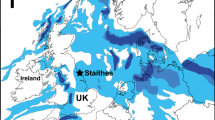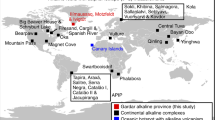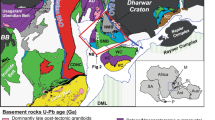Abstract
SIGNIFICANT Archaean bedded sulphate deposits have been described only from the Pilbara Block (Western Australia)1,2, the Barberton Mountainland (South Africa)3–6 and southern India7. These are all barite deposits, but there is petrographic evidence suggesting replacement of original evaporitic gypsum in the North Pole (Pilbara) and Barberton deposits. This contrasts with the apparent volcanogenic deposition of barite in the relatively sulphide-rich Big Stubby prospect (Pilbara). This letter summarises the petrographic evidence, concentrating on recent data from North Pole, and reports stable isotopic results for barite and associated sulphides which provide corroborative evidence for the environments of formation of these deposits. Some implications concerning the early hydrosphere, atmosphere and biosphere are outlined.
This is a preview of subscription content, access via your institution
Access options
Subscribe to this journal
Receive 51 print issues and online access
$199.00 per year
only $3.90 per issue
Buy this article
- Purchase on Springer Link
- Instant access to full article PDF
Prices may be subject to local taxes which are calculated during checkout
Similar content being viewed by others
References
Hickman, A. H. Geol. Survey of Western Australia, A. Rep. 1972, 57–60 (1973).
Perry, E. C. Hickman, A. H. & Barnes, I. L. Geol. Soc. Am. Abstr. 1226 (1975).
Viljoen, R. P. & Viljoen, M. J. Geol. Soc. South Africa, Spec. Pub. 2, 221–244 (1969).
Heinrichs, T. K. & Reimer, T. O. Econ. Geol. 72, 1426–1441 (1977).
Perry, E. C., Monster, J. & Reimer, T. Science 171, 1015–1016 (1971).
Vinogradov, Y. I., Reimer, T. O., Leites, A. M. & Smelov, S. M. Lithol. Miner. Resources 11, 407–420 (1976).
Radhakrishna, B. P. & Vasudev, V. N. J. Geol. Soc. India 18, 525–541 (1977).
Dunlop, J. S. R. thesis, Univ. Western Australia (1976).
Dunlop, J. S. R. Archaean Cherty Metasediments: Their Sedimentology, Micropalaeontology, Biochemistry and Significance to Mineralization (eds Glover, J. E. & Groves, D. I.) 30–38 (University of Western Australia, Perth, 1978).
Dunlop, J. S. R., Muir, M. D., Milne, V. A. & Groves, D. I. Nature 274, 676–678 (1978).
Lipple, S. L. Geol. Survey of Western Australia, A. Rep. 1974, 58–63 (1975).
Pidgeon, R. T. Earth planet. Sci. Lett. 37, 421–428 (1978).
Richter-Bernburg, G. Messinian Events in the Mediterranean (ed. Drooger, W.) 124–149 (North-Holland, Amsterdam, 1973).
Igarishi, T., Okabe, K., Yasima, J. Geology of Kuroko Deposits (ed. Ishihara, S.) 39–44 (Society of Mining Geologists, Japan, 1974).
Shawe, D. R., Poole, F. G. & Brosst, D. A. Econ. Geol. 64, 242–254 (1969).
Reynolds, D. G., Brook, W. A., Marshall, A. E. & Allchurch, P. D. Economic Geology of Australia and Papua New Guinea (ed. Knight, C. L.) 1, 185–195 (Aust. Inst. Min. Met. 1975).
Sangster, D. F. & Brook, W. A. Nature 270, 423 (1977).
Muir, M. D. & Grant, P. R. The Early History of the Earth (ed. Windley, B. F.) 595–604 (Wiley, New York, 1976).
Jahn, B. M., Shih, C. Y. Geochim. cosmochim. Acta 38, 873–885 (1974).
Dunlop, J. S. R. & Groves, D. I. Archean Cherty Metasediments: Their Sedimentology, Micropalaeontology, Biochemistry and Significance to Mineralization (eds Glover, J. E. & Groves, D. I.) 39–44 (University of Western Australia, Perth 1978).
Fontes, J. C. & Pierce, C. Abstr. 10th Int. Congr. Sedimentology 215–216 (1978).
Veizer, J. & Hoefs, J. Geochim. cosmochim. Acta 40, 1387–1395 (1976).
Holser, W. T. & Kaplan, I. R. Chem. Geol. 1, 93–135 (1966).
Donnelly, T. H. et al. J. Geol. Soc. Aust. 24, 409–420 (1978).
Sangster, D. F. Handbook of Strata–Bound and Stratiform ore Deposit (ed. Wolfe, K. H.) 2, 219–262 (1976).
Ohmoto, H. Econ. Geol. 67, 551–578 (1972).
Berkner, L. V. & Marshall, L. C. J. atmos. Sci. 23, 133–143 (1966).
Goodwin, A. M., Monster, J. & Thode, H. G. Econ. Geol. 71, 870–892 (1976).
Degens, E. T. & Stoffers, P. Nature 263, 22–27 (1976).
Drever, J. I. Geol. Soc. Am. Bull. 85, 1099–1106 (1974).
Author information
Authors and Affiliations
Rights and permissions
About this article
Cite this article
LAMBERT, I., DONNELLY, T., DUNLOP, J. et al. Stable isotopic compositions of early Archaean sulphate deposits of probable evaporitic and volcanogenic origins. Nature 276, 808–811 (1978). https://doi.org/10.1038/276808a0
Received:
Accepted:
Published:
Issue Date:
DOI: https://doi.org/10.1038/276808a0
This article is cited by
-
Pelagic barite precipitation at micromolar ambient sulfate
Nature Communications (2017)
-
Sulfur mass-independent fractionation in subsurface fracture waters indicates a long-standing sulfur cycle in Precambrian rocks
Nature Communications (2016)
-
Isotopic evidence for microbial sulphate reduction in the early Archaean era
Nature (2001)
-
Sulphide minerals in early Archean chemical sedimentary rocks of the eastern Pilbara district, Western Australia
Mineralogy and Petrology (1998)
Comments
By submitting a comment you agree to abide by our Terms and Community Guidelines. If you find something abusive or that does not comply with our terms or guidelines please flag it as inappropriate.



